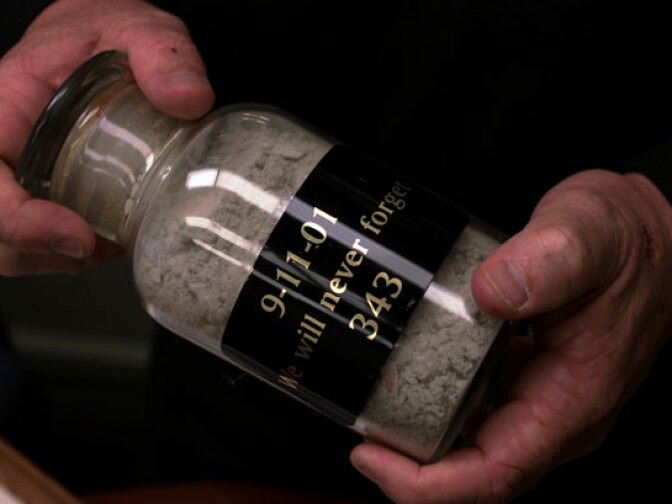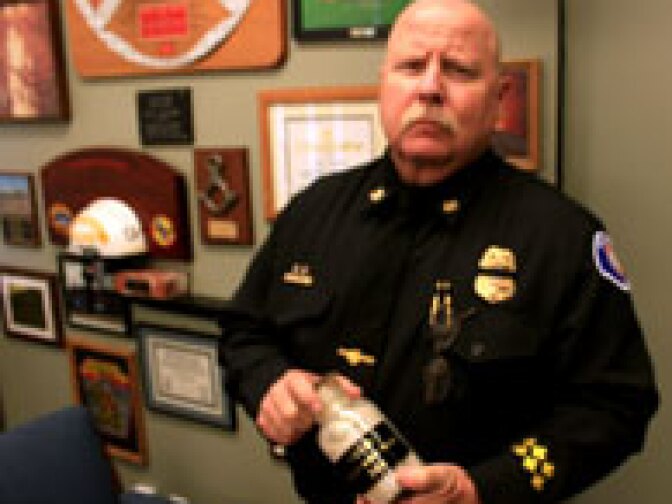With our free press under threat and federal funding for public media gone, your support matters more than ever. Help keep the LAist newsroom strong, become a monthly member or increase your support today.
Redlands fire chief reflects on experience as 9/11 emergency responder
Hours after the 9/11 attacks, Redlands Fire Chief Jeff Frazier found himself on a military jet headed for New York City.
“On a C-141 towards the evening of the 11th, it was pretty clear to all of us, that we were essentially at war,” remembers Frazier, at the time a deputy chief with the San Diego Fire Department.
Frazier was among dozens of first responders dispatched on Sept. 11 as part of the Federal Emergency Management Agency’s Urban Search Rescue Team. The is holding a public remembrance this weekend for victims of the Sept. 11 terrorist attacks.
“If you’ve ever been inside a military aircraft, it’s pretty darn loud, not conducive to conversation,” says Frazier. “But the talks that we did have, we were making contingency plans and lists on what we would be facing and how we would react, to prepare for what might be occurring.”
Newly released video footage recorded by FEMA offers a glimpse of what awaited the team. In one video, a weary unidentified firefighter pauses amidst the ruin on that first night. “You’re tired, you’re sweaty — so what?” he says. “There are thousands of people buried in there; couple hundred firemen, couple hundred cops. You’re afraid to have the sun come up and see what it looks like then, you know?”
“I saw pictures before I got there too and I thought I understood,” says Frazier. He divided his time between Ground Zero and a command center at New York City’s Javits Convention Center. “I can absolutely tell you that you have no comprehension of what it was like. And when we arrived, the magnitude of it was, it was just terrible — and terrifying.”
It wasn’t Jeff Frazier’s first national disaster. The veteran firefighter helped lead search and rescue efforts after numerous hurricanes.
It wasn’t his first search and rescue mission following a terrorist attack, either. He was also deployed for what up until Sept. 11 was the most deadly act of terrorism on American soil: The 1995 bombing of the Murrah Federal Building in Oklahoma City.
None of it prepared him for the panorama of destruction in lower Manhattan. “Everything was pulverized,” says Frazier. “There was no wood, no concrete other than pieces here and there. Thirty-story buildings covered with dust, broken windows for blocks,” he remembers.
“It was an indication this was going to be a recovery operation," says Frazier. "If it made desks and concrete into this — people didn’t have much of a shot. How tiny we seemed, compared to the disaster.”
The FEMA team made no live rescues during Frazier’s 30 days at the site.
“It was body recovery, and we were doing our best to preserve the dignity, and help the families that were waiting to find out for sure if their loved one was lost,” says Frazier.
The bodies and human remains were delivered to a coroner team. “Bodies in these type of situations take on almost a mannequin look because of the dust and the debris so that it kinda protects your psyche as far as the sight [of the dead] but, to me, the smell was something that I definitely brought home.”
Frazier also brought home an 8x10 picture, which now hangs in his office alongside awards and commendations from his 30-year career.
“I don’t know if, you can’t really see it here — that’s me,” says Frazier, pointing to himself perched on a rooftop, swaddled in yellow protective gear. “I’m standing on a high-rise adjacent to Ground Zero site.”
Thirty stories below is a smoldering urban canyon of ruin. Jagged shards of the Twin Towers’ steel skin jut from the ground like broken teeth.
“That’s actually people there, working in that debris," Frazier says. "The San Diego Urban Search and Rescue team is down in here, you can just see the yellow dots from their brush gear [yellow protective fire suits].”
Frazier also brought back another grim memento. He picks up a small glass jar filled with pale grey ash and bits of scorched paper scooped from Ground Zero.
“When you turn it the right way you can just see the 'To' and 'From' on a memo inside here,” says Frazier, turning the jar in his hands. “But you didn’t see file cabinets and things, and even the concrete, most of it was just obliterated into this dust.”
After a month at Ground Zero, Frazier returned to his wife and three young daughters in San Diego. He wondered then what to tell his girls about the attacks, what to say to make them feel safe as he left for New York on Sept. 11.
He wonders now about what he’ll tell people at a 9/11 memorial this weekend in Redlands. “I’m not worthy,” he says. “Other people gave their lives. But I’ve been asked, and I’ll do my best.”
That jar of ash in Chief Frazier’s office bears a simple inscription: “We Will Never Forget.”
Frazier won’t. He can’t.









